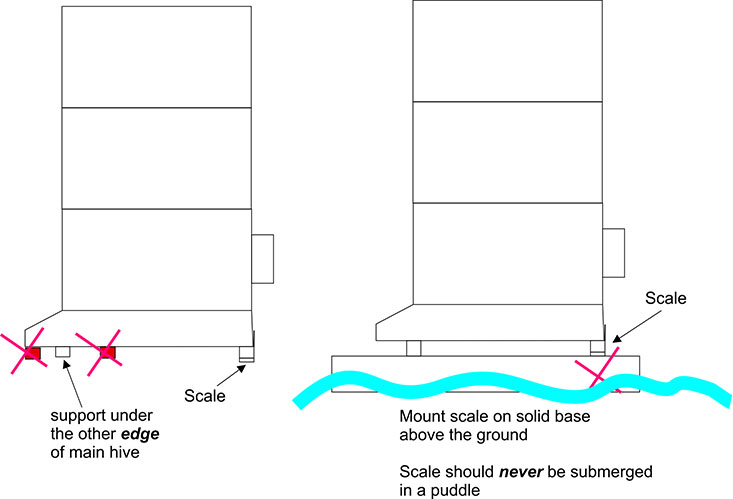Sensor Installation

The hive scale sensor is placed under one edge of the hive. Screw holes are provided to further stabilize the sensor brackets to the hive or to the base. The opposite end of the hive (the hinge side) can be supported with a block of wood to level out the hive. The placement of the hinged side should be directly under the opposite edge of the main hive body.
The hive scale sensor should not be installed in a way that it will ever be submerged in a puddle of water.
The hive needs to be placed on a solid base. In our testing over the last year, beekeepers had their hives supported in a variety of creative ways – before adding the scale. If the ground under the hive can be kept somewhat dry, the ground itself will provide a firm foundation for the hive base. In other words, "squishy mud" is not the most reliable foundation when attempting to measure the weight.
- One beekeeper had a pair of long telephone poles in parallel supported on the ends by bricks. His hives were set on top of the poles along their length and consequently were not in touch with the ground at all. Here is a website that has a similar concept: http://www.keepingbackyardbees.com/building-a-bee-hive-stand/
- Another hive was set on an oversized patio tile, or “Paver” that was larger than the base of the hive all around. Under the Paver were the actual supports. These supports were tucked under a few inches away from the edges of the Paver. The Paver acted as a "roof" for the brick supports that were touching the dryer ground. The hive was placed on top of the Paver.
- Another beekeeper had his hive sitting on a wooden pallet which served to provide weight distribution along the ground over a larger area than the hive.
There are measurements that are seen in the data that don’t reflect the activity of the bees and need to be factored in to the beekeepers mindset as he/she looks for trends in the hive. When the hive gets wet from rain (top, sides), a slight increase in the weight of the hive is seen in the data. Also, snow collecting on the hive is reflected in the data. There can be indications in the data from a heavy rain pelting against one side of the hive and running down the side causing one side of the ground to be softer than the other as the hive shifts its weight to the softer side slightly. Also, if the ground under a hive is wet and freezes in the winter, and the sun comes out and thaws one side, the weight in the hive can shift and be reflected in the data. The latter two points underscore the strategy to provide a solid base for the hive.
